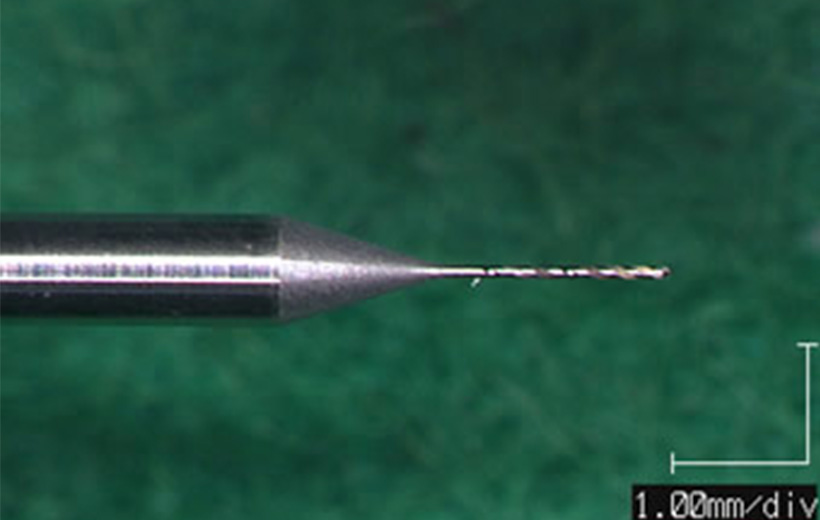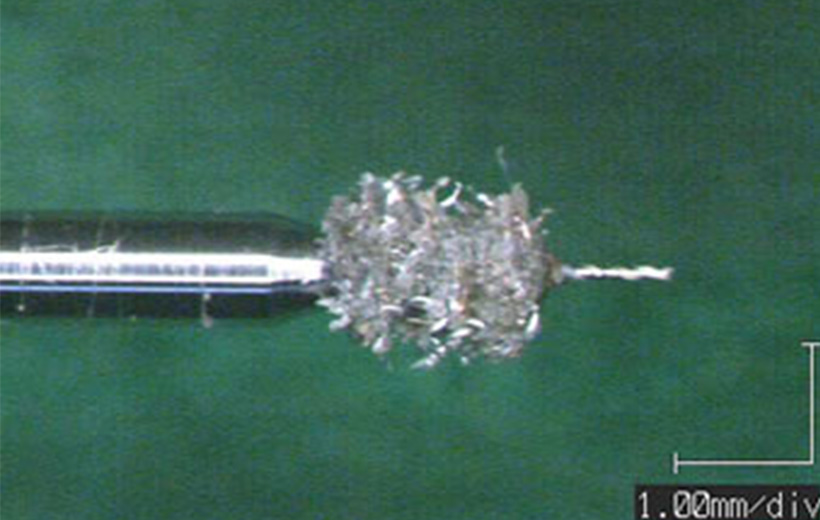Bird nesting occurs by poor discharge of the PWB material and entry board material chips. They coil up around the end of flute. Generally, bird nesting of copper will occur in ø0.6-ø3.175mm and ID drilling. In the case of micro drills, bird nesting will be caused by the entry board material (especially resin).

Non Bird Nesting

Bird Nesting
| Cause | Failure condition | Countermeasure |
|---|---|---|
| Small chip pocket (flute volume) | Poor chip evacuation causes bird nesting. | Enlarge chip pocket volume, change web thickness, web taper, and flute land ratio. |
| Short flute length | Poor chip evacuation causes bird nesting at the flute end. | Apply suitable flute length for stack height. |
| Large helix angle | The axial direction does not promote good chip evacuation, causing Bird Nesting at the end of the flute | Lower helix angle. |
| Small point angle | Because the Chip isn't cut (divided), it becomes a continuous form. | Enlarge point angle. |
| Cause | Failure condition | Countermeasure |
|---|---|---|
| Low chipload / Low spindle speed | Low chipload generates a long, thin chip form, causing Bird Nesting at the end of the flute. Low spindle speed removes the centrifugal force effect to drive the swarf away | Higher chipload / Higher spindle speed |
| Penetrating too deep into the backup board | Materials such as Backing Board generate large particles of swarf which can adhere to the drill causing Bird Nesting. | Set suitable penetration depth. |
| No dwell time between drilling strokes | Bird Nesting occurs because the drill has not completed the evacuation process | Use dwell time. |
| Cause | Failure condition | Countermeasure |
|---|---|---|
| Thick lubricant resin on entry board | Bird nesting occurs at end of flute, and can cause breakage in extreme cases. | Change to thinner lubricant layer type. (Note that this can cause hole registration accuracy to worsen) |
| Unsuitable entry board | On thicker PCB's, bird nesting occurs more easily because of the uncut chip from the entry board. | Consider suitable thickness. |
| Hinge number and thickness of PCB copper layers | Bird nesting occurs because of spiral copper chip. | Higher chipload |
| Cause | Failure condition | Countermeasure |
|---|---|---|
| Unsuitable bush diameter (restricted air flow) | Chip evacuation is less effective due to the smaller inner bush. | Change large diameter bush. |
| Unsuitable vacuum force | Poor chip evacuation is increased with a low vacuum force, especially with larger ID drills | Set a suitable vacuum force. Clean pressure foot and hoses. Maintain dust catcher. |
PRODUCT 01 PCB Drills / Routers / Ultra precision micro-hole drill